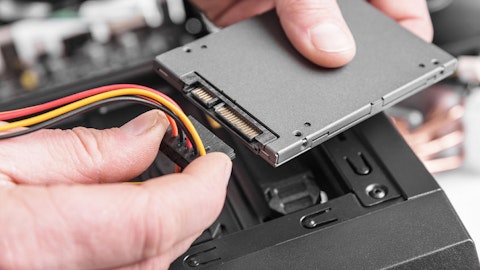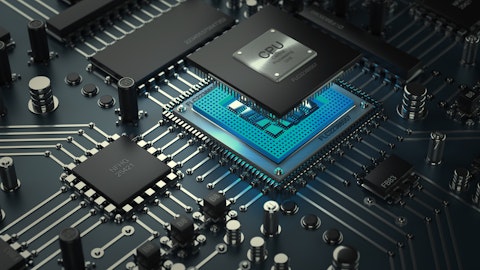We won’t get everyone. I don’t think that’s possible. But the relationship is very good. We think they’ve been a great customer to us and I think they’ll still be a great customer to us this year. That’s really all I can tell you.
Brian Chin: Okay. No. That’s fair enough. Appreciate that. And then can you provide maybe a little bit more insight into the types of maybe AI oriented applications that you’re engaging with customers across the many verticals that you referenced earlier? Maybe any sort of — helping us sort of understand sort of what’s contributing to your optimism, not just kind of, fiscal second half of this year, but clearly in the out years as well in terms of the type of funnel that you’re building?
Mark Adams: Yeah. If you look at, by the way, my next comment isn’t about stuff we’ve deployed today, but where we’re seeing a lot of discussions around applications with customers. In the energy sector, things like oil and gas exploration. In the financial markets, we all know that the financial markets, a tenth of a second is worth something in the trading world. You think about healthcare and geonetics. You think about applications like retail and ATMs and decision around how to serve their customer. You think about social media and advertising and knowing exactly what your behaviors are and matching that to the buying opportunities out in ecommerce on the web. There’s just endless applications that are in front of us and that’s how we’re working.
And by the way, I haven’t even mentioned the federal opportunities around defense and the likes. So I think what I do want to mention, by the way, and it rhymes with what we’ve said on the last call is, I think, 2023, yeah, it was the iPhone moment, but people didn’t really know how to use it till later and that’s true now. I think there was a lot of sales of GPUs to infrastructure, people starting to lay the pipes and I’m not even sure all the people who bought GPUs know how to use them. And I think 2024 and 2025, it’s going to be the year where two things happen, A, businesses get a little bit more clear on what they’re going to get out of AI, and two, they’re going to realize that they need deployment and management expertise to make sure that these AI systems perform as they thought and as they invested in.
And so I think that’s going to play very well to us from our managed service and software approach.
Brian Chin: Yeah. That’s very helpful. Thanks, Mark.
Mark Adams: Of course.
Operator: Thank you for your question. [Operator Instructions]
Mark Adams: Operator, is there another question here in the queue.
Operator: Yes. Yes. Give me one moment. Sorry about that. Our next question comes from the line of Quinn Bolton with Needham. Your line is now open.
Nick Doyle: Hey, guys. This is Nick Doyle on for Quinn. Thanks for letting us ask a question. Could you give a little more detail on maybe how much inventory is left in the end markets? I know you talked about inventory and memory solutions in the remarks and guide. Maybe is there more in the channel versus end customer and then any detail on LED inventory? I mean, I know we’re going into seasonality next quarter and China has kind of negative news coming out, so not surprising there. But are we still kind of pretty clean inventory on the LED side as well?
Mark Adams: Yeah. So let me take the market update on that piece and I’ll hand it to Ken for kind of the quantitative parameters. In the memory side, I’m sticking to what I said on our last quarter’s call that it kind of feels like spring at the earliest when we start to see the demand piece of memory contribute to the recovery. As I said last quarter, the dynamic going on now is just a little bit of game of chicken where pricing is going up on certain skews. There’s inventory in the channel and they’re kind of like slogging it out a little bit in negotiation. I mean, they, the big semiconductor guys. We’re not impacted necessarily as much about the price more on the demand and I see that the inventory, I believe the inventory is like a spring calendar year timing to get back to regular levels.
I think we can start to see some good solid foundation and demand generation. On the LED side, it’s actually been less of an inventory in the channel dynamic and more of an end market demand. As a matter of fact, our channel is pretty lean. I’ll let Ken talk to that, so I’ll hand it over to him. But, all in all, obviously, our inventory, we feel pretty good about our own balance sheet, but the memory thing will play out. I speculate it’s probably spring and the LED one more demand generation and some of the things going on in the broader macro environment.
Ken Rizvi: Yeah. So, as Mark outlined and just to give you a data point on the LED side, if we look at the distribution inventory, we probably burned off north of $20 million, getting close to $25 million from — in the last five quarters or so. And so we’ve leaned out, we’re at now normal turns levels within the distribution channel and that’s essentially around sort of fourth of 4 times. And so, as Mark highlighted, the inventory has leaned out in LED within the distributors and it’s really a function of demand. Q2, however, just one way to think about it is, we do have Chinese New Year. Typically, things shut down for the better part of one week to 10 days and that’s what we’re seeing in terms of the impact of the business Q1 to Q2 in terms of sales and the big driver as we head into Q3 and beyond is going to be demand.
Nick Doyle: Okay. That makes sense. Looking at IPS, maybe a little different angle. You have this press release last November talking about a partnership with Google Cloud. Could you talk about how that relationship is progressing and maybe where you use that control plane technology?




